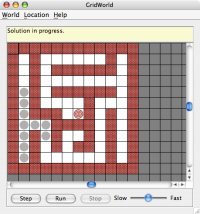GridWorld version of maze solver
 I don't teach in a high school, but I'm aware how large the case
study looms in an AP class; I haven't rewritten the handout materials
but I did put together a sort of proof-of-concept solution to my CS2
assignment using GridWorld as the underlying framework instead of AWT
and applets and 2D arrays, and removing the enumerated types.
I also simplified it to assume a queue-based
agenda, removing another layer of complexity from the problem. As such,
I'd say it now sits somewhat earlier, difficulty-wise, although still on
the AB (CS2) end of things: you could do this assignment pretty much as
soon as they've seen either a queue or a stack.
I don't teach in a high school, but I'm aware how large the case
study looms in an AP class; I haven't rewritten the handout materials
but I did put together a sort of proof-of-concept solution to my CS2
assignment using GridWorld as the underlying framework instead of AWT
and applets and 2D arrays, and removing the enumerated types.
I also simplified it to assume a queue-based
agenda, removing another layer of complexity from the problem. As such,
I'd say it now sits somewhat earlier, difficulty-wise, although still on
the AB (CS2) end of things: you could do this assignment pretty much as
soon as they've seen either a queue or a stack.
With respect to the CS2 version of the project, the three preliminary
assignments are modified as follows. Agenda simply goes away; reading
from a file into a 2D array is mostly the same, except you're reading
into a Grid; and instead of making a Square enum, you'll need some other
representation (I used an abstract Square class with concrete subclasses
Wall, Finish, Explored, and so on). In the main project, you then skip
straight to the "The maze solver" portion.
Above is a sample screenshot of a my implementation, with the
maze solution in progress. (Click it for a full-size version.) Here
the start point is in the lower-left, and the grey circles represent a
square that has been explored. The target marks the finish.
A few implementation notes
If you want to read in mazes from files, and have the size of the maze
declared in the file (as in the CS2 version of the assignment), you have
a slight problem: to inherit from BoundedGrid, you need to know at the
start of construction (when super(...) is called) what the bounds are.
In my implementation, I inherited from UnboundedGrid instead, but that's
a little icky. Alternatives include requiring all mazes to have the
same dimensions, or requiring the dimensions to be specified on the
command line in addition to or instead of in the file. Also not
optimal.
Because the World GUI provides a pre-determined set of buttons, the
interface has to be simpler than the CS2 version gives. In particular,
there's no easy way to input a filename here, which is why I put it on
the command line. Also, there's no easy way inside the GUI to swap a
stack for a queue, so that'll require a recompile (or you could do it as
a command-line option).
There are many ways to implement Square or its equivalent.
I define Square as an abstract type with concrete subclasses
Wall, Finish, and so on, which lets me make use of
GridWorld's ability to automatically take a GIF (it should be PNG!
Boo!) of the same name as the class as its icon.
Solution?
This page is too easily googlable, so I don't want to post it here,
but I'm happy to email the solution to any CS teacher.
Just email me at
dblaheta@knox.edu. Preferably,
email from your school email account, and if possible include a link to
some official school website that includes your name on faculty/staff (so I can
verify that this is on the up-and-up).
 I don't teach in a high school, but I'm aware how large the case
study looms in an AP class; I haven't rewritten the handout materials
but I did put together a sort of proof-of-concept solution to my CS2
assignment using GridWorld as the underlying framework instead of AWT
and applets and 2D arrays, and removing the enumerated types.
I also simplified it to assume a queue-based
agenda, removing another layer of complexity from the problem. As such,
I'd say it now sits somewhat earlier, difficulty-wise, although still on
the AB (CS2) end of things: you could do this assignment pretty much as
soon as they've seen either a queue or a stack.
I don't teach in a high school, but I'm aware how large the case
study looms in an AP class; I haven't rewritten the handout materials
but I did put together a sort of proof-of-concept solution to my CS2
assignment using GridWorld as the underlying framework instead of AWT
and applets and 2D arrays, and removing the enumerated types.
I also simplified it to assume a queue-based
agenda, removing another layer of complexity from the problem. As such,
I'd say it now sits somewhat earlier, difficulty-wise, although still on
the AB (CS2) end of things: you could do this assignment pretty much as
soon as they've seen either a queue or a stack.